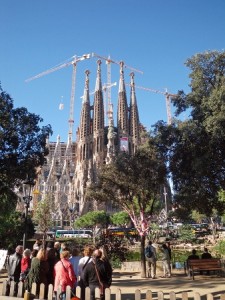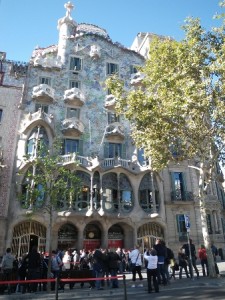By Chris Millikan
 At the turn of the 20th-century, Antonio Gaudi and other Catalan architects created inventive, fanciful and flamboyant structures in Barcelona. Before cruising to other southern European ports aboard the Nieuw Amsterdam, we ramble among these glorious legacies.
At the turn of the 20th-century, Antonio Gaudi and other Catalan architects created inventive, fanciful and flamboyant structures in Barcelona. Before cruising to other southern European ports aboard the Nieuw Amsterdam, we ramble among these glorious legacies.
Three master pieces near Catalunya square interpret modernist design differently, suggesting competition to locals who nickname this area Apple of Discord. Amid Montaner’s Morera House and Cadafalch’s Amatller House we sight Batllo House, said to be purely Gaudian. With flowing sculpted stonework, arched rooflines and rounded features, its broken mosaic wall tiles sparkle greenish-blue and golden orange in the morning sun. Our interest piqued, we locate other renowned works.
Casa Mila aka La Pedrera dominates another block. Completed in 1912, this apartment block’s spectacular rippled façade curves smoothly ‘round the street corner; tiered wrought-iron balconies resemble a series of waves. Without straight lines, this building proves even more unconventional than Casa Batllo. Walls rest against arches and pillars supporting ceilings of varying heights. Apartments surround central courtyards, one circular and the other oval.
Hopping a bus for Park Guell, our Sunday walk in this magical public park begins along footpaths winding among Mediterranean landscapes and under arcades created with columns mimicking tree trunks. Inside the Gaudi Museum, his home from 1906-1926, his whimsical art nouveau furniture, lighthearted sketches and architectural models bedazzle us.
From the Gran Placa Circular aka main terrace, we sight two delightful fairytale pavilions sprouting fanciful roofs and brightly tiled pinnacles…and beyond, sweeping vistas of Barcelona. An incredible serpentine mosaic bench borders this lively plaza. Apparently Gaudi created its curvaceous seats using buttock imprints left by a naked workman sitting in wet clay! We try them out as a guitar trio fills the air with jazz and once rested, visit artisans’ selling wares from blankets shaded by umbrellas.
A cellist’s soothing notes entice us into the hall of columns just below. Resplendent in the sun, a mosaic dragon playfully embraces a trickling fountain near the main entrance, where the underground whisks us to Gaudi’s most celebrated masterwork.
La Sagrada Familia’s elaborate Gothic pinnacles, columns and arches soar skyward. Statuary recounting Christian lore adorns spectacular undulating surfaces. This monumental church of the Holy Family accommodates 10,000 worshippers and 1,300-voice choir. The interior suggests a forest in shades of green, in tune with Gaudi’s overarching natural themes. After dedicating 44 years to this massive project, Gaudi died with only one quarter finished. Scheduled completion in 2026 coincides with the centennial of his untimely death.
 Southward, Casa Calvet was built a few blocks off La Rambla for textile manufacturer Pere Calvet. Gaudi’s most conventional house and the only one of his designs receiving an award: Barcelona’s Building of the Year in 1900. According to scholars, such symmetry, balance and order are unusual in his plans.
Southward, Casa Calvet was built a few blocks off La Rambla for textile manufacturer Pere Calvet. Gaudi’s most conventional house and the only one of his designs receiving an award: Barcelona’s Building of the Year in 1900. According to scholars, such symmetry, balance and order are unusual in his plans.
At a crossroads of narrow medieval streets stands a marvelous concert hall. Palau de la Musica Catalana, Montaner’s opulent red brick palace of music drips with rich ornamentation: elaborate floral motifs, tile work and statuary.
In La Ribera district we pass gothic palaces with huge arched doorways and Santa Maria del Mar, Barcelona’s magnificent 14th-century cathedral. Five adjoining palaces make up Museo Picasso where 35,000 permanent pieces of Pablo Picasso’s work include his first major paintings and earliest notebooks revealing his developing artistic flair.
In the Raval district we encounter Palau Guell, a gothic mansion Gaudi created for Eursebi Guell, his great patron. Frequently used for social, literary and artistic gatherings, glittering receptions held there during the 1888’s International Exposition spread word of Gaudi’s genius.
Sampling Barcelona’s celebrated cityscapes kick off ten enchanted days of European sightseeing!
When You Go:
*Holland America offers summer European cruise itineraries; five springtime sailings explore the Caribbean. Possibilities: http://www.holandamerica.com/Main.action
ladamerica.com/main/Main.action